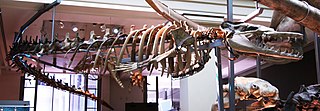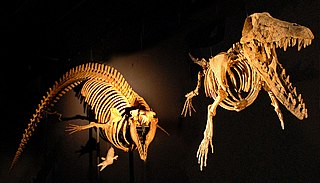
Ambulocetus is a genus of early amphibious cetacean from the Kuldana Formation in Pakistan, roughly 48 or 47 million years ago during the Early Eocene (Lutetian). It contains one species, Ambulocetus natans, known solely from a near-complete skeleton. Ambulocetus is among the best-studied of Eocene cetaceans, and serves as an instrumental find in the study of cetacean evolution and their transition from land to sea, as it was the first cetacean discovered to preserve a suite of adaptations consistent with an amphibious lifestyle. Ambulocetus is classified in the group Archaeoceti—the ancient forerunners of modern cetaceans whose members span the transition from land to sea—and in the family Ambulocetidae, which includes Himalayacetus and Gandakasia.

Basilosaurus is a genus of large, predatory, prehistoric archaeocete whale from the late Eocene, approximately 41.3 to 33.9 million years ago (mya). First described in 1834, it was the first archaeocete and prehistoric whale known to science. Fossils attributed to the type species B. cetoides were discovered in the United States. They were originally thought to be of a giant reptile, hence the suffix "-saurus", Ancient Greek for "lizard". The animal was later found to be an early marine mammal, which prompted attempts at renaming the creature, which failed as the rules of zoological nomenclature dictate using the original name given. Fossils were later found of the second species, B. isis, in 1904 in Egypt, Western Sahara, Morocco, Jordan, Tunisia, and Pakistan. Fossils have also been unearthed in the southeastern United States and Peru.

Basilosauridae is a family of extinct cetaceans. They lived during the middle to the early late Eocene and are known from all continents, including Antarctica. They were probably the first fully aquatic cetaceans. The group is noted to be a paraphyletic assemblage of stem group whales from which the monophyletic Neoceti are derived.

Dorudon ("spear-tooth") is a genus of extinct basilosaurid ancient whales that lived alongside Basilosaurus 40.4 to 33.9 million years ago in the Eocene. It was a small whale, with D. atrox measuring 5 metres (16 ft) long and weighing 1–2.2 metric tons. Dorudon lived in warm seas around the world and fed on small fish and mollusks. Fossils have been found along the former shorelines of the Tethys Sea in present-day Egypt and Pakistan, as well as in the United States, New Zealand and Western Sahara.

Archaeoceti, or Zeuglodontes in older literature, is a paraphyletic group of primitive cetaceans that lived from the Early Eocene to the late Oligocene. Representing the earliest cetacean radiation, they include the initial amphibious stages in cetacean evolution, thus are the ancestors of both modern cetacean suborders, Mysticeti and Odontoceti. This initial diversification occurred in the shallow waters that separated India and Asia 53 to 45 mya, resulting in some 30 species adapted to a fully oceanic life. Echolocation and filter-feeding evolved during a second radiation 36 to 35 mya.

Zygorhiza ("Yoke-Root") is an extinct genus of basilosaurid early whale known from the Late Eocene of Louisiana, Alabama, and Mississippi, United States, and the Bartonian to the late Eocene of New Zealand . Specimens reported from Europe are considered Dorudontinae incertae sedis.
Pachycetus is an extinct genus of pachycetine basilosaurid from Middle Eocene of the eastern United States and Europe. The best known remains generally suggest that Pachycetus lived during the Bartonian, however, fossil finds have also been recovered from sediments of less certain age that could suggest that it may have also lived during the Late Lutetian and Early Priabonian. Pachycetus is primarily known from vertebrae and ribs and is characterized by its highly osteosclerotic and pachyostotic skeleton. This means the bones not only featured thickened rings of cortical bone surrounding the internal cancellous bone, but the cortical bone was furthermore much denser than in other basilosaurids. Two species of Pachycetus are recognized: Pachycetus paulsonii from Europe and Pachycetus wardii from the United States. A third species might be represented by "Zeuglodon" wanklyni.

Georgiacetus is an extinct genus of ancient whale known from the Eocene period of the United States. Fossils are known from Georgia, Alabama, and Mississippi and protocetid fossils from the right time frame, but not yet confirmed as Georgiacetus, have been found in Texas and South Carolina.

Cynthiacetus is an extinct genus of basilosaurid early whale that lived during the Late Eocene Specimens have been found in the southeastern United States and Peru.
Basiloterus is an extinct genus of late-Eocene archaeocete whale from the Drazinda Formation in southwestern Punjab, Pakistan and possibly also the Barton Group of England. Known from two isolated lumbar vertebrae, the elongated nature of these elements has been taken as possible evidence that Basiloterus was a close relative of the better-known Basilosaurus. This was also the reasoning behind its name, which roughly translates to "another king". However, publications since then not only lead to some major changes of the internal relationships within Basilosauridae but have also called into question how diagnostic elongated vertebrae are for members of this group, as other early whales have developed similar anatomy independently. Though the identity of Basiloterus as a basilosaurid is generally maintained, its exact position within more recent interpretations of the family is unclear.
Chrysocetus is a genus of extinct early whale known from Late Eocene-aged fossils of the eastern United States and western Africa.

Ocucajea is an extinct genus of basilosaurid cetacean from Middle Eocene deposits of southern Peru. Ocucajea is known from the holotype MUSM 1442, a partial skeleton. It was collected in the Archaeocete Valley site, from the Paracas Formation of the Pisco Basin about 40.4 to 37.2 million years ago.

Supayacetus is an extinct genus of basilosaurid cetacean from Middle Eocene deposits of southern Peru.
Babiacetus is an extinct genus of early cetacean that lived during the late Lutetian middle Eocene of India . It was named after its type locality, the Harudi Formation in the Babia Hills, Kutch District, Gujarat, India.

Llanocetus is a genus of extinct toothed baleen whales from the Late Eocene of Antarctica. The type species, Llanocetus denticrenatus, reached gigantic proportions, with the juvenile specimen reaching an estimated 8 m (26 ft) in length; a second, unnamed species, known only from three isolated premolar teeth, reached an estimated total body length of up to 12 m (39 ft). Like other contemporary baleen whales of the Eocene, Llanocetus completely lacked baleen in its jaws. It was probably a suction feeder like the modern beaked and pygmy right whales.

Coronodon is a genus of toothed (transitional) baleen whales from the Early Oligocene Ashley and Chandler Bridge formations of South Carolina. The genus contains three species: the type species C. havensteini, and additional species C. newtonorum and C. planifrons.
Phiomicetus is a genus of protocetid whale that lived between 43 and 42 million years ago during the Lutetian period in what is now Egypt. It had powerful jaws and large teeth that would have allowed it to hunt and tear large prey.
Pachycetinae is an extinct subfamily of basilosaurid cetaceans that lived during the middle Eocene. The best dated remains stem from Bartonian strata, but some finds suggest that they could have first appeared during the Lutetian and may have survived until the Priabonian. Fossils of pachycetines are chiefly known from the southern United States, Ukraine, Morocco and Germany, among others. They differ from other basilosaurids in having pachyostotic and osteosclerotic vertebrae and ribs, making them denser and heavier by comparison. Based on this it has been suggested that these whales lived in shallow waters and that these thickened bones act as a buoyancy control as seen in sirenians. Analysis of the teeth suggests that pachycetines had a varying diet, with the robust teeth of the larger Pachycetus indicating that it possibly fed on sharks, whereas the more gracile teeth of Antaecetus suggest a diet of smaller prey items. The clade currently only includes two genera, Antaecetus and Pachycetus, but a 2023 study suggests that the Peruvian Supayacetus may at least be a close relative.

Antaecetus is an extinct genus of pachycetine basilosaurid from the middle Eocene Aridal Formation of Morocco as well as the Fayum, Egypt. Antaecetus, although known from fewer remains in total, is markedly more complete than the closely related Pachycetus, with one specimen preserving large parts of the vertebral column up to the lumbar vertebrae and a well preserved skull. Based on these remains Antaecetus appears to have been smaller than Pachycetus, with a proportionally smaller head and much more gracile teeth. Both genera however share a highly osteosclerotic and pachyostotic skeleton, greatly increasing their weight and possibly serving as additional ballast. In turn the elongation and thickening of the vertebrae severely impacts the animals movement, most likely causing it to have been much slower and far less mobile than other archaeocetes. It has been proposed that Antaecetus was a slow moving inhabitant of shallow coastal waters, where it would ambush fish and marine molluscs. Only a single species of Antaecetus is known, Antaecetus aithai, which was originally described as a species of Pachycetus.
Tupelocetus is an extinct genus of early cetacean found in the Bartonian Middle Eocene Tupelo Bay Formation, in Berkeley County, South Carolina.





















